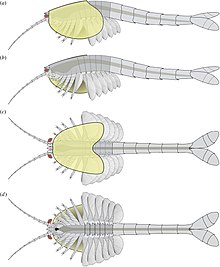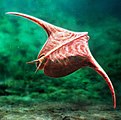Hymenocarina
| Hymenocarina Temporal range: | |
|---|---|

| |
| Diagram of Waptia | |

| |
| Fossil of Canadaspis perfecta | |
| Scientific classification | |
| Domain: | Eukaryota |
| Kingdom: | Animalia |
| Phylum: | Arthropoda |
| Clade: | Mandibulata |
| Order: | †Hymenocarina Størmer, 1944 |
| Genera | |
| |
| Synonyms | |
|
Canadaspidida Novozhilov in Orlov, 1960 | |
Hymenocarina is an order of extinct arthropods known from the Cambrian. They possess bivalved carapaces, typically with exposed posteriors. Members of the group are morphologically diverse and had a variety of ecologies, including as filter feeders and as predators. Recent research has generally considered them to be stem or crown group members of Mandibulata, due to the presence of mandibles in some species.
Taxonomy
Hymenocarines are characterized by the combination of following characters: bivalved, convex carapace covering cephalothoracic region; cephalothorax bearing multisegmented antennules and rounded mandibles, alongside post-maxillular limbs with spiny, subdivided basis and endopods with well-developed terminal claws; absence of appendages between antennules and mandibles; median sclerite and lobate protrusions located between compound eyes; posterior tagma (abdomen) with ring-like segments and terminated by a pair of well-developed caudal rami.[2][1]
Based on the interpretation of simple head region that possess only a few segments and appendages, hymenocarine taxa were thought to be part of the upper stem-group euarthropods in early and mid 2010s.[3][4][5][6][7][8][9][10] They later became widely accepted as mandibulates (jawed arthropods) after the discovery of their mandible-bearing mouthparts in late 2010s.[2][1][11][12] Since then, most phylogenetic analysis suggest hymenocarines represent part of the mandibulate stem-group,[2][13][1][14][15][16][17][18] with some results suggest a rather crownward position such as stem-pancrustaceans,[1][19][20][18] stem-myriapods,[1] stem-hexapods[16] or somewhere in-between the former taxa.[21]
Several subgroups within the order are recognised, including Waptiidae[1] and Protocarididae.[2] The internal relationships of Hymenocarina are unstable, and it is unclear whether the group is monophyletic or paraphyletic.[22][23]
Cambrian bivalved arthropods are now recognised to be a polyphyletic group, with other groups of bivalved arthropods such as the Isoxyida, Bradoriida and Phosphatocopina only distantly related to Hymenocarina.[17][24][25][26] Chuandianella a bivalved arthropod morphologically similar to Waptia and long thought to be closely related[1][21] was reinterpreted as a non-hymenocarine euarthropod based on a restudy published in 2022, which found that it definitely lacked mandibles, characteristic of true hymenocarines.[24]
Diversity
- Life restoration of Waptia
- Life restoration of Canadaspis laevigata
- Only 2 cm-long Fibulacaris is suggested to have swum upside down
- Large-sized Balhuticaris shows extreme multisegmentation with over 100 segments
- Unlike other taxa, eyes of possible hymenocarine Erjiecaris were probably placed over carapace
- The carapace of possible hymenocarine Pseudoarctolepis had wing-like projections
The group was very diverse in shape, with some forms like Waptia somewhat resembling shrimp,[1] and others like Odaraia having a large carapace and trifurcate tail.[27] The appendages showing various degrees of specialization across the group, ranging from the feathery gills of Waptia[1] to the robust claws of Tokummia.[2] They also had a wide range of sizes with some like Fibulacaris reaching a length of up to 2 cm (0.79 in) long,[28] while largest Balhuticaris reached 24.5 cm (9.6 in) long.[23] Hymenocarines are thought to have been ecologically diverse, with various forms occupying scavenging, predatory, deposit feeding and suspension feeding niches.[23]
References
- ^ a b c d e f g h i j k l m n o Vannier, Jean; Aria, Cédric; Taylor, Rod S.; Caron, Jean-Bernard (2018). "Waptia fieldensis Walcott, a mandibulate arthropod from the middle Cambrian Burgess Shale". Royal Society Open Science. 5 (6): 172206. doi:10.1098/rsos.172206. PMC 6030330. PMID 30110460.
- ^ a b c d e Aria, Cédric; Caron, Jean-Bernard (2017-04-26). "Burgess Shale fossils illustrate the origin of the mandibulate body plan". Nature. 545 (7652): 89–92. doi:10.1038/nature22080. ISSN 0028-0836. PMID 28445464. S2CID 4454526.
- ^ Legg, David A.; Sutton, Mark D.; Edgecombe, Gregory D.; Caron, Jean-Bernard (2012-12-07). "Cambrian bivalved arthropod reveals origin of arthrodization". Proceedings of the Royal Society B: Biological Sciences. 279 (1748): 4699–4704. doi:10.1098/rspb.2012.1958. PMC 3497099. PMID 23055069.
- ^ Legg, David (2013). "Multi-Segmented Arthropods from the Middle Cambrian of British Columbia (Canada)". Journal of Paleontology. 87 (3): 493–501. doi:10.1666/12-112.1. ISSN 0022-3360. S2CID 86725173.
- ^ Legg, David A.; Vannier, Jean (2013-09-16). "The affinities of the cosmopolitan arthropod Isoxys and its implications for the origin of arthropods". Lethaia. 46 (4): 540–550. doi:10.1111/let.12032. ISSN 0024-1164.
- ^ Legg, David A.; Sutton, Mark D.; Edgecombe, Gregory D. (2013-09-30). "Arthropod fossil data increase congruence of morphological and molecular phylogenies". Nature Communications. 4 (1): 2485. doi:10.1038/ncomms3485. ISSN 2041-1723. PMID 24077329.
- ^ Ortega-Hernández, Javier (2014-12-21). "Making sense of 'lower' and 'upper' stem-group Euarthropoda, with comments on the strict use of the name Arthropoda von Siebold, 1848". Biological Reviews. 91 (1): 255–273. doi:10.1111/brv.12168. PMID 25528950. S2CID 7751936.
- ^ Ortega-Hernández, Javier; Janssen, Ralf; Budd, Graham E. (2017-05-01). "Origin and evolution of the panarthropod head – A palaeobiological and developmental perspective". Arthropod Structure & Development. Evolution of Segmentation. 46 (3): 354–379. doi:10.1016/j.asd.2016.10.011. ISSN 1467-8039. PMID 27989966.
- ^ Yang, Jie; Ortega-Hernández, Javier; Legg, David A.; Lan, Tian; Hou, Jin-bo; Zhang, Xi-guang (2018-02-01). "Early Cambrian fuxianhuiids from China reveal origin of the gnathobasic protopodite in euarthropods". Nature Communications. 9 (1): 470. Bibcode:2018NatCo...9..470Y. doi:10.1038/s41467-017-02754-z. ISSN 2041-1723. PMC 5794847. PMID 29391458.
- ^ Daley, Allison C.; Antcliffe, Jonathan B.; Drage, Harriet B.; Pates, Stephen (2018-05-22). "Early fossil record of Euarthropoda and the Cambrian Explosion". Proceedings of the National Academy of Sciences. 115 (21): 5323–5331. Bibcode:2018PNAS..115.5323D. doi:10.1073/pnas.1719962115. ISSN 0027-8424. PMC 6003487. PMID 29784780.
- ^ Giribet, Gonzalo; Edgecombe, Gregory D. (2019-06-17). "The Phylogeny and Evolutionary History of Arthropods". Current Biology. 29 (12): R592 – R602. doi:10.1016/j.cub.2019.04.057. ISSN 0960-9822. PMID 31211983. S2CID 189926344.
- ^ Edgecombe, Gregory D. (2020-11-02). "Arthropod Origins: Integrating Paleontological and Molecular Evidence". Annual Review of Ecology, Evolution, and Systematics. 51 (1): 1–25. doi:10.1146/annurev-ecolsys-011720-124437. ISSN 1543-592X. S2CID 225478171.
- ^ Aria, Cédric; Caron, Jean-Bernard (2017-12-21). "Mandibulate convergence in an armoured Cambrian stem chelicerate". BMC Evolutionary Biology. 17 (1): 261. doi:10.1186/s12862-017-1088-7. ISSN 1471-2148. PMC 5738823. PMID 29262772.
- ^ Zeng, Han; Zhao, Fangchen; Niu, Kecheng; Zhu, Maoyan; Huang, Diying (2020-12-03). "An early Cambrian euarthropod with radiodont-like raptorial appendages". Nature. 588 (7836): 101–105. doi:10.1038/s41586-020-2883-7. PMID 33149303. S2CID 226248177.
- ^ Aria, Cédric; Zhao, Fangchen; Zhu, Maoyan (2021-09-01). "Fuxianhuiids are mandibulates and share affinities with total-group Myriapoda". Journal of the Geological Society. 178 (5). doi:10.1144/jgs2020-246. ISSN 0016-7649. S2CID 233952670.
- ^ a b Anderson, Evan P.; Schiffbauer, James D.; Jacquet, Sarah M.; Lamsdell, James C.; Kluessendorf, Joanne; Mikulic, Donald G. (2021-04-19). "Stranger than a scorpion: a reassessment of Parioscorpio venator, a problematic arthropod from the Llandoverian Waukesha Lagerstätte". Palaeontology. 64 (3): 429–474. doi:10.1111/pala.12534. ISSN 0031-0239. S2CID 234812878.
- ^ a b Izquierdo‐López, Alejandro; Caron, Jean‐Bernard (2021-06-15). "A Burgess Shale mandibulate arthropod with a pygidium: a case of convergent evolution". Papers in Palaeontology. 7 (4): 1877–1894. doi:10.1002/spp2.1366. ISSN 2056-2799. S2CID 236284813.
- ^ a b O'Flynn, Robert; Williams, Mark; Yu, Mengxiao; Harvey, Thomas; Liu, Yu (2022-02-11). "A new euarthropod with large frontal appendages from the early Cambrian Chengjiang biota". Palaeontologia Electronica. 25: a6. doi:10.26879/1167. S2CID 246779634.
- ^ Aria, Cédric; Caron, Jean-Bernard (2019). "A middle Cambrian arthropod with chelicerae and proto-book gills". Nature. 573 (7775): 586–589. doi:10.1038/s41586-019-1525-4. ISSN 1476-4687. PMID 31511691. S2CID 202550431.
- ^ Aria, Cédric; Zhao, Fangchen; Zeng, Han; Guo, Jin; Zhu, Maoyan (2020-01-08). "Fossils from South China redefine the ancestral euarthropod body plan". BMC Evolutionary Biology. 20 (1): 4. doi:10.1186/s12862-019-1560-7. ISSN 1471-2148. PMC 6950928. PMID 31914921.
- ^ a b Ou, Qiang; Vannier, Jean; Yang, Xianfeng; Chen, Aiiln; Huijuan, Mai; Shu, Degan; Han, Jian; Fu, Dongjing; Wang, Rong; Mayer, Georg (2020-04-29). "Evolutionary trade-off in reproduction of Cambrian arthropods". Science Advances. 6 (18): 3376–3405. doi:10.1126/sciadv.aaz3376. PMC 7190318. PMID 32426476. S2CID 218675348.
- ^ Izquierdo-López, Alejandro; Caron, Jean-Bernard (December 2022). "The problematic Cambrian arthropod Tuzoia and the origin of mandibulates revisited". Royal Society Open Science. 9 (12): 220933. doi:10.1098/rsos.220933. ISSN 2054-5703. PMC 9727825. PMID 36483757.
- ^ a b c Izquierdo-López, Alejandro; Caron, Jean-Bernard (2022-07-15). "Extreme multisegmentation in a giant bivalved arthropod from the Cambrian Burgess Shale". iScience. 25 (7): 104675. doi:10.1016/j.isci.2022.104675. ISSN 2589-0042. PMC 9283658. PMID 35845166. S2CID 250057171.
- ^ a b Zhai, Dayou; Williams, Mark; Siveter, David J.; Siveter, Derek J.; Harvey, Thomas H. P.; Sansom, Robert S.; Mai, Huijuan; Zhou, Runqing; Hou, Xianguang (2022-02-22). "Chuandianella ovata: An early Cambrian stem euarthropod with feather-like appendages". Palaeontologia Electronica. 25 (1): 1–22. doi:10.26879/1172. ISSN 1094-8074. S2CID 247123967.
- ^ Izquierdo-López, Alejandro; Caron, Jean-Bernard (2019). "A possible case of inverted lifestyle in a new bivalved arthropod from the Burgess Shale". Royal Society Open Science. 6 (11): 191350. doi:10.1098/rsos.191350. PMC 6894550. PMID 31827867.
- ^ Zeng, Han; Zhao, Fang-Chen; Yin, Zong-Jun; Zhu, Mao-Yan (September 2021). "A new early Cambrian bivalved euarthropod from Yunnan, China and general interspecific morphological and size variations in Cambrian hymenocarines". Palaeoworld. 30 (3): 387–397. doi:10.1016/j.palwor.2020.09.002.
- ^ Briggs, D. E. G. (1981). "The Arthropod Odaraia alata Walcott, Middle Cambrian, Burgess Shale, British Columbia". Philosophical Transactions of the Royal Society of London. Series B, Biological Sciences. 291 (1056): 541–582. JSTOR 2395403.
- ^ Izquierdo-López, Alejandro; Caron, Jean-Bernard (2019). "A possible case of inverted lifestyle in a new bivalved arthropod from the Burgess Shale". Royal Society Open Science. 6 (11): 191350. doi:10.1098/rsos.191350. PMC 6894550. PMID 31827867.









